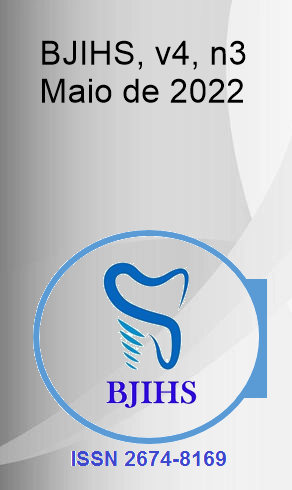Resumo
Introdução: A técnica de redução interproximal do esmalte (RIE) é um meio de ganhar espaço como parte do tratamento ortodôntico abrangente. Após uma cuidadosa revisão da literatura, o artigo discute técnicas de redução de esmalte interproximal. Objetivos: Este artigo tem como objetivos traçar um histórico, indicações, contra-indicações, vantagens, desvantagens e precauções da redução do esmalte interproximal. Metodologia: Foram pesquisados no google acadêmico os unitermos “interproximal”, “desgaste”, esmalte”, “tratamento ortodôntico”. A pesquisa resultou em mais de trinta mil artigos publicados sobre o tema. Foram selecionados os 18 artigos com maior número de citações dentro do google acadêmico. Resultados: A técnica de redução interproximal do esmalte, quando usada corretamente para os casos certos, pode servir como uma forma eficaz de ganhar espaço durante o tratamento ortodôntico. Se a técnica for utilizada corretamente, não há evidências de que seja de alguma forma deletéria para os tecidos duros ou moles dentários.
Referências
- Peck, Harvey, and Sheldon Peck. "An index for assessing tooth shape deviations as applied to the mandibular incisors." American journal of orthodontics 61.4 (1972): 384-401.
- Ballard, Murray L. "Asymmetry in tooth size: a factor in the etiology, diagnosis and treatment of malocclusion." The Angle Orthodontist 14.3 (1944): 67-70.
- Begg, P. Raymond. "Stone age man's dentition: with reference to anatomically correct occlusion, the etiology of malocclusion, and a technique for its treatment." American journal of orthodontics 40.4 (1954): 298-312.
- Hudson, Arthur Leroy. "A study of the effects of mesiodistal reduction of mandibular anterior teeth." American Journal of Orthodontics 42.8 (1956): 615-624.
- Bolton, Wayne A. "Disharmony in tooth size and its relation to the analysis and treatment of malocclusion." The Angle Orthodontist 28.3 (1958): 113-130.
- Kelsten, L. B. "A technique for realignment and stripping of crowded lower incisors." JPO: the Journal of Practical Orthodontics 3.2 (1969): 82-84.
- Rogers, Glenn A., and Martin J. Wagner. "Protection of stripped enamel surfaces with topical fluoride applications." American Journal of Orthodontics 56.6 (1969): 551-559.
- Paskow, Herbert. "Self-alignment following interproximal stripping." American Journal of Orthodontics 58.3 (1970): 240-249.
- Shillingburg Jr, H. T., and C. Scott Grace. "Thickness of enamel and dentin." Journal-Southern California Dental Association 41.1 (1973): 33-6.
- PECK, SHELDON, and HARVEY PECK. "Crown dimensions and mandibular incisor alignment." The Angle Orthodontist 42.2 (1972): 148-153.
- Tuverson, Donald L. "Anterior interocclusal relations Part I." American journal of orthodontics 78.4 (1980): 361-370.
- Doris, John M., Brentley W. Bernard, and Mladen M. Kuftinec. "A biometric study of tooth size and dental crowding." American journal of orthodontics 79.3 (1981): 326-336.
- Betteridge, Margaret Ann. "The effects of interdental stripping on the labial segments evaluated one year out of retention." British Journal of Orthodontics 8.4 (1981): 193-197.
- Sheridan JJ. Air-rotor stripping. J Clin Orthod 1985;19:43-59
- Sheridan, John J. "Air-rotor stripping update." J. Clin. Orthod. 21 (1987): 781-788.
- BU, Zachrisson. "Zachrisson on excellence finishing. Part I." J Clin Orthod 20.8 (1986): 536-556.
- Kesling, Harold D. "The philosophy of the tooth positioning appliance." American Journal of Orthodontics and Oral Surgery 31.6 (1945): 297-304.
- Begg, Percy Raymond, and Peter C. Kesling. Begg orthodontic theory and technique. WB Saunders Company, 1977.

Este trabalho está licenciado sob uma licença Creative Commons Attribution 4.0 International License.
Copyright (c) 2022 Jamille dos Passos Lacerda
